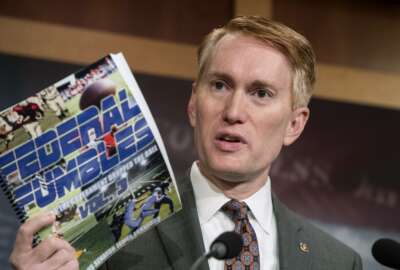

Sen. James Lankford (R-Okla.) wants to launch a three-pronged attack on government spending through greater accountability and reform of the budget and oversight...
Sen. James Lankford (R-Okla.) has gotten a lot of attention for his “Federal Fumbles” report, which he released last week and highlights 100 examples of the government’s wasteful spending, lack of oversight, needed structural changes and wasted effort. Now he’s talking about ways to fix the problems.
Toward that end, he’s pushing legislation that would make it easier for the average American to track down these instances themselves.
“You cannot find duplication in government right now unless you go to the [Government Accountability Office], and ask them,” Lankford said at a Dec. 7 Cato Institute event on Curbing Wasteful Spending. “They’ll take 18 months and do a study and come back and give you the results of that. That should take 18 seconds and a Google search. Not 18 months with a GAO search.”
That’s why he’s trying to help shepherd the Taxpayer’s Right to Know Act through the Senate. The House version has already passed.
The legislation focuses on transparency, and would require the Office of Management and Budget to create a searchable database of all federal programs and list their cost, the number of employees on the program, who the beneficiaries of the program are, and any efficiency reports on the program from the GAO, relevant inspectors general and other watchdog organizations.
Lankford said duplication needs to be easier to identify, because it’s not like agencies set out to create duplicative programs on purpose. Instead, he said, it usually originates with some executive request for agencies to look into a specific problem and find out what they could do about it. Then each agency stands up its own individual program, and absent coordination, each program evolves independently to fulfill the same functions.
He also took the time to address the budget process. He called for reforms, saying the current process has existed since 1974, and has only worked four times.
“We should admit we don’t wear the same ties and the same belts that we did in 1974; we probably don’t need to have the same budget process we’ve had since 1974,” Lankford said. “So let’s look at it again. And stop saying ‘this year it’s going to work, this year it’s going to work.’ It’s not, and it won’t work next year either.”
He said that Congress should pass a budget every two years, rather than yearly. That would allow more predictability for the agencies, he said. It would also allow for more time to put the budget together, and more time to conduct oversight.
“If you give more time to the appropriations staff to do more oversight, they’re more able to be able to accomplish that because of the time they have to do it,” he said.
And the current oversight system is more hindrance than help when it comes to fixing some of these problems, Lankford said, because every agency is beholden to three committees, and they aren’t aligned properly anymore. That causes two problems. First, it’s more likely that someone on one of the committees will hold up the entire process until a new Congress begins.
And second, when multiple committees are responsible for a single problem, one of two things happens: either all three committees are stumbling over one another to get something done because the issue has drawn media focus, or nothing at all gets done because everyone assumes someone else will handle it.
Copyright © 2025 Federal News Network. All rights reserved. This website is not intended for users located within the European Economic Area.
Daisy Thornton is Federal News Network’s digital managing editor. In addition to her editing responsibilities, she covers federal management, workforce and technology issues. She is also the commentary editor; email her your letters to the editor and pitches for contributed bylines.
Follow @dthorntonWFED


